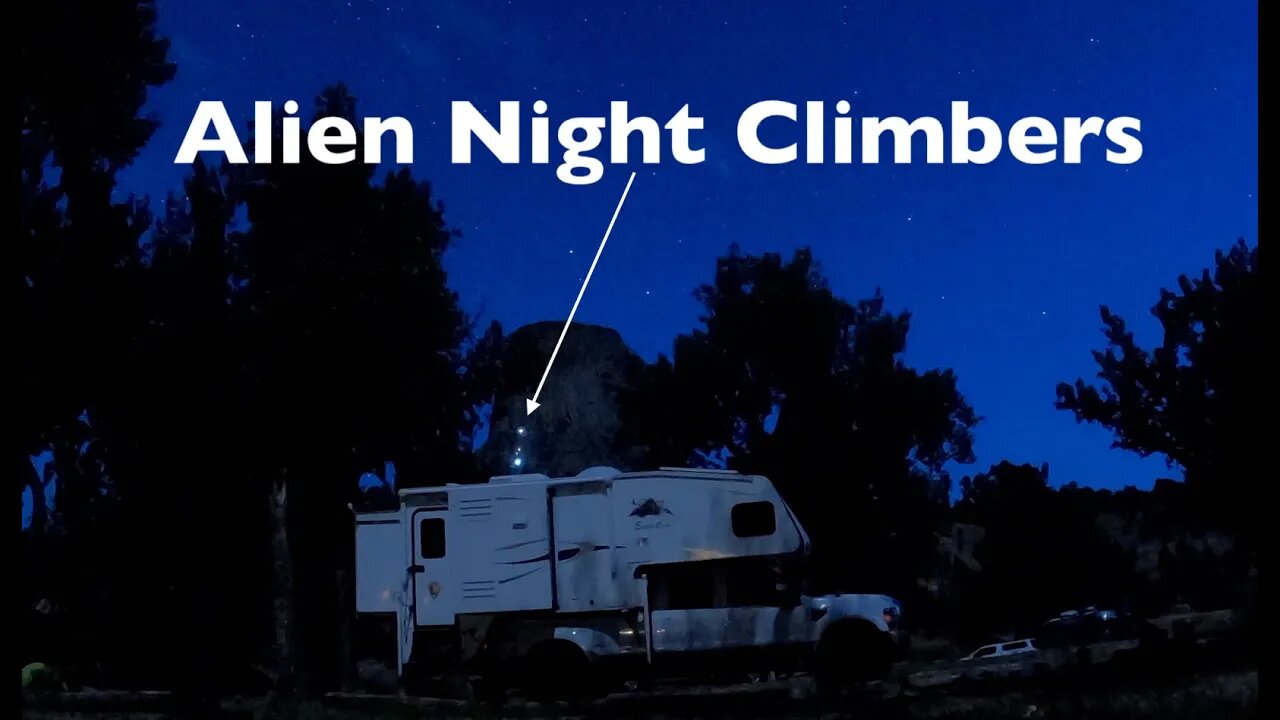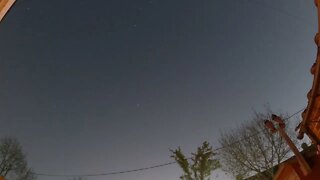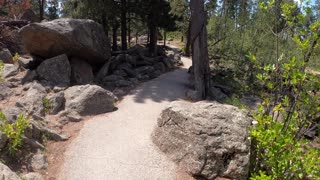Premium Only Content

Aliens climb Devils Tower in a Night Lapse video Richard Dreyfuss seen in area.
The landscape surrounding Devils Tower is composed mostly of sedimentary rocks. The oldest rocks visible in Devils Tower National Monument were laid down in a shallow sea during the Triassic.[citation needed] This dark red sandstone and maroon siltstone, interbedded with shale, can be seen along the Belle Fourche River. Oxidation of iron minerals causes the redness of the rocks. This rock layer is known as the Spearfish Formation. Above the Spearfish Formation is a thin band of white gypsum, called the Gypsum Springs Formation, Jurassic in age.[citation needed] Overlying this formation is the Sundance Formation.[16] During the Paleocene Epoch, 56 to 66 million years ago, the Rocky Mountains and the Black Hills were uplifted.[citation needed] Magma rose through the crust, intruding into the existing sedimentary rock layers.[17]
Devils Tower is composed of a porphyritic phonolite (left), and close-up view of the columns (right)
Geologists Carpenter and Russell studied Devils Tower in the late 19th century and came to the conclusion that it was formed by an igneous intrusion.[18] In 1907, geologists Nelson Horatio Darton and C. C. O'Harra (of the South Dakota School of Mines) theorized that Devils Tower must be an eroded remnant of a laccolith.[19]
The igneous material that forms the Tower is a phonolite porphyry intruded about 40.5 million years ago,[neutrality is disputed][20] a light to dark-gray or greenish-gray igneous rock with conspicuous crystals of white feldspar.[21] As the magma cooled, hexagonal columns formed (though sometimes 4-, 5-, and 7-sided columns were possible), up to 20 feet (6.1 m) wide and 600 feet (180 m) tall.
As rain and snow continue to erode the sedimentary rocks surrounding the Tower's base, more of Devils Tower will be exposed. Nonetheless, the exposed portions of the Tower still experience certain amounts of erosion. Cracks along the columns are subject to water and ice erosion. Portions, or even entire columns, of rock at Devils Tower are continually breaking off and falling. Piles of broken columns, boulders, small rocks, and stones, called scree, lie at the base of the tower, indicating that it was once wider than it is today.[17]
Close Encounters of the Third Kind is a 1977 American science fiction film written and directed by Steven Spielberg, starring Richard Dreyfuss, Melinda Dillon, Teri Garr, Bob Balaban, Cary Guffey, and François Truffaut. It tells the story of Roy Neary, an everyday blue-collar worker in Indiana, whose life changes after an encounter with a UFO.
Close Encounters was a long-cherished project for Spielberg. In late 1973, he developed a deal with Columbia Pictures for a science-fiction film. Though Spielberg received sole credit for the script, he was assisted by Paul Schrader, John Hill, David Giler, Hal Barwood, Matthew Robbins, and Jerry Belson, all of whom contributed to the screenplay in varying degrees. The title is derived from Ufologist J. Allen Hynek's classification of close encounters with extraterrestrials, in which the third kind denotes human observations of extraterrestrials or "animate beings". Douglas Trumbull served as the visual effects supervisor, while Carlo Rambaldi designed the extraterrestrials.
Made on a production budget of $19.4 million, Close Encounters was released in a limited number of cities on November 16[4] and 23, 1977,[5] before expanding into wide release the following month. It was a critical and financial success, eventually grossing over $300 million worldwide. The film received numerous awards and nominations at the 50th Academy Awards, 32nd British Academy Film Awards, the 35th Golden Globe Awards and the 5th Saturn Awards, and has been widely acclaimed by the American Film Institute.
In December 2007, it was deemed "culturally, historically, or aesthetically significant" by the United States Library of Congress and selected for preservation in the National Film Registry.[6][7] A Special Edition of the film, featuring both shortened and newly added scenes, was released theatrically in 1980. Spielberg agreed to do the special edition to add more scenes that they were unable to include in the original release, with the studio demanding a controversial scene depicting the interior of the extraterrestrial mothership.[8] Spielberg's dissatisfaction with the altered ending scene led to a third version of the film, referred to as the Director's Cut, that was issued on VHS and LaserDisc in 1998 (and later DVD and Blu-ray). The director's cut is the longest version of the film, combining Spielberg's favorite elements from both previous editions but removing the scenes inside the extraterrestrial mothership.[9] The film was later remastered in 4K and re-released in theatres on September 1, 2017 for its 40th anniversary.[10]
-
 1:11
1:11
Retrodude
2 years agoShort night lapse video
22 -
 4:38
4:38
rkenney1966
2 years agoDevils Tower National Monument
66 -
 DVR
DVR
Flyover Conservatives
21 hours agoInsider Reacts to Trump’s 100 Hours: Davos, WHO, Climate Change, DEI… - Alex Newman | FOC Show
17.6K -
 1:04:30
1:04:30
Battleground with Sean Parnell
8 hours agoPresident Trump Is Flooding The Zone
104K10 -
 LIVE
LIVE
We Like Shooting
14 hours agoWe Like Shooting 595 (Gun Podcast)
148 watching -

megimu32
4 hours agoON THE SUBJECT: 90s Toys, Fat Phobia, and Crying Libs!
15.9K2 -
 LIVE
LIVE
Right Side Broadcasting Network
12 hours agoLIVE REPLAY: President Trump Addresses House GOP in Doral, FL - 1/27/25
4,143 watching -
 2:37:19
2:37:19
Robert Gouveia
6 hours agoTrump Addresses House Republicans; Tulsi Confirmation Fight; CIA Lab Leak
48.2K25 -
 54:38
54:38
LFA TV
1 day agoMankind Refuses the Way of Peace | TRUMPET DAILY 1.27.25 7pm
42.6K3 -
 1:41:27
1:41:27
2 MIKES LIVE
8 hours ago2 MIKES LIVE #171 Deep Dive Monday!
27K1